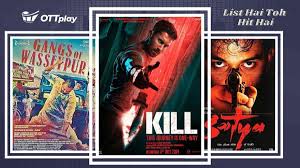Dissect the Indian Noir Cinema brilliantly mesh together the harsh conditions of urban life and the stylistic details of the noir genre making you journey through crime’s underbelly expressing the knottiness of contemporary Indian society. Using the landscapes of shadowy city streets and gritty tales, film artists explore subjects such as moral ambivalence, debasement, and the angst of existence.
The Evolution of Indian Noir
Origins and Influences
While film noir originated in Hollywood during the 1940s, its themes and aesthetics found a resonant echo in Indian cinema. Early Indian films like Bees Saal Baad (1962) and Woh Kaun Thi? (1964) incorporated elements of suspense and moral complexity, laying the groundwork for a uniquely Indian interpretation of noir. (The Guardian, OpenEdition Journals)
Socio-Political Context
The rapid urbanization and socio-political upheavals in post-independence India provided fertile ground for noir narratives. Cities like Mumbai became emblematic of both opportunity and despair, mirroring the duality often explored in noir films.
Cinematographic Techniques in Indian Noir
Use of Light and Shadow
Indian noir cinematography employs high-contrast lighting, deep shadows, and dramatic camera angles to create tension and uncertainty in urban settings. This visual style accentuates the moral ambiguity and psychological depth of characters.(Fiveable, Wikipedia)
Urban Landscapes as Characters
In Indian noir, the cityscape is not just a backdrop but a character in itself. Films like Parinda (1989) transform iconic Mumbai landmarks into spaces of terror and moral conflict, reflecting the city’s complex identity. (Wikipedia)
Notable Films and Their Impact
Parinda (1989)
Directed by Vidhu Vinod Chopra, Parinda is often credited with bringing realism to mainstream Hindi cinema. The film’s portrayal of Mumbai’s underworld and its use of shadowy visuals exemplify Indian noir aesthetics. (Wikipedia)
Satya (1998)
Ram Gopal Varma’s Satya offers a gritty, realistic depiction of Mumbai’s criminal underbelly. Its narrative complexity and stylistic choices have influenced a generation of filmmakers, solidifying its status as a cornerstone of Indian noir. (Wikipedia)
Monsoon Shootout (2013)
Amit Kumar’s Monsoon Shootout explores the moral dilemmas faced by a rookie cop in Mumbai. The film’s non-linear narrative and atmospheric visuals contribute to its noir sensibility. (Wikipedia)
Themes Explored in Indian Noir
Moral Ambiguity
Characters in Indian noir often grapple with ethical dilemmas, blurring the lines between right and wrong. This complexity reflects the nuanced realities of urban life.
Corruption and Power Dynamics
The pervasive presence of corruption in political and social structures is a recurring theme. Films depict how power dynamics influence individual choices and societal outcomes.(OpenEdition Journals)
Identity and Alienation
Urban settings in Indian noir often highlight the alienation and identity crises experienced by individuals amidst the chaos of city life.
The Future of Indian Noir
Just as in its society so too in its movies, India grows. The new narrative and visual vocabulary still continues to evlovle as new filmmakers are experimenting and pushing the boundaries, making Indian noir exciting and genre to look forward to.
Indian noir can act as an illuminating lens to access the labyrinth of urban experience. With its unique cinematography and intense themes it’s bound to mesmerise and make you think about the issues the world faces.
Frequently Asked Questions (FAQ)
Q1: What defines Indian noir cinematography?
Indian noir cinematography is characterized by high-contrast lighting, deep shadows, and urban settings that reflect the moral and psychological complexities of the characters.
Q2: How does Indian noir differ from traditional film noir?
While traditional film noir originated in Hollywood and often focuses on crime and moral ambiguity, Indian noir incorporates local socio-political contexts, cultural nuances, and urban landscapes unique to India.(ResearchGate)
Q3: Why are urban landscapes significant in Indian noir films?
Urban landscapes in Indian noir serve as more than just backdrops; they are integral to the narrative, symbolizing the chaos, corruption, and complexities of modern life.
Q4: Can you recommend some Indian noir films to watch?
Notable Indian noir films include Parinda (1989), Satya (1998), and Monsoon Shootout (2013), each offering unique perspectives on urban life and moral dilemmas.(Wikipedia)
Q5: Is Indian noir still relevant today?
Absolutely. Indian noir continues to evolve, addressing contemporary issues and resonating with audiences through its exploration of urban challenges and human complexities.